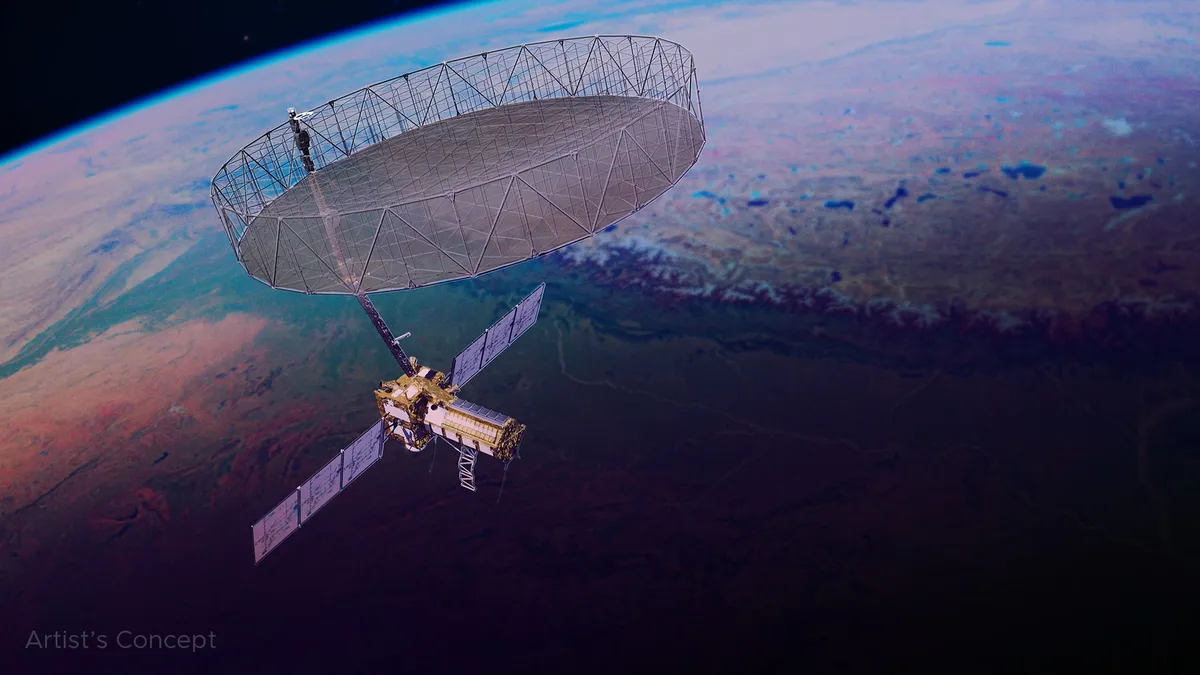
Spanning an impressive 39 feet (12 meters), the drum-shaped antenna reflector on the NISAR (NASA-ISRO Synthetic Aperture Radar) satellite mission has successfully unfurled in low Earth orbit. This mission, a collaborative effort between NASA and the Indian Space Research Organisation (ISRO), marks a significant advancement in satellite technology for Earth observation.
The reflector, which had been stowed in an umbrella-like fashion, was deployed after the 30-foot (9-meter) boom that supports it was locked into position. Launched by ISRO on July 30 from the Satish Dhawan Space Centre in India, NISAR will play a crucial role in tracking the motion of ice sheets and glaciers, monitoring land deformation caused by earthquakes, volcanoes, and landslides, and observing changes in forest and wetland ecosystems down to fractions of an inch.
NISAR will significantly aid decision-makers in diverse fields such as disaster response, infrastructure monitoring, and agriculture. “The successful deployment of NISAR’s reflector marks a significant milestone in the capabilities of the satellite,” said Karen St. Germain, director of the Earth Science Division at NASA Headquarters in Washington. “The data NISAR is poised to gather will have a major impact on how global communities and stakeholders improve infrastructure, prepare for and recover from natural disasters, and maintain food security.”
This mission carries the most sophisticated radar systems ever launched as part of a NASA initiative. Uniquely, NISAR combines two synthetic aperture radar (SAR) systems: an L-band system that can penetrate clouds and forest canopies, and an S-band system that also sees through clouds but is more sensitive to light vegetation and moisture in snow. The successful deployment of the reflector is crucial for the operation of both systems, highlighting the mission's technological advancements.
“This is the largest antenna reflector ever deployed for a NASA mission, and we were eager to see the deployment go well,” stated Phil Barela, NISAR project manager at NASA’s Jet Propulsion Laboratory (JPL) in Southern California. “It’s a critical part of the NISAR Earth science mission and has taken years to design, develop, and test to be ready for this big day. Now that we’ve launched, we are focusing on fine-tuning it to begin delivering transformative science by late fall of this year.”
The reflector weighs about 142 pounds (64 kilograms) and features a cylindrical frame constructed from 123 composite struts and a gold-plated wire mesh. On August 9, the satellite’s boom began unfolding, joint by joint, until it reached its full extension about four days later. The reflector assembly, mounted at the boom's end, was then freed on August 15 using small explosive bolts, initiating a process known as the “bloom.” This process allowed the antenna to unfurl by releasing the tension stored in its flexible frame, similar to opening an umbrella.
Subsequent activation of motors and cables pulled the antenna into its final, locked position. Designed to capture images of Earth’s surface down to pixels approximately 30 feet (10 meters) across, the reflector's diameter is about as wide as a school bus is long. Utilizing SAR processing, NISAR's reflector simulates a traditional radar antenna that would need to be 12 miles (19 kilometers) long to achieve the same resolution as the satellite.
“Synthetic aperture radar works like the lens of a camera, focusing light to create a sharp image. The size of the lens, known as the aperture, determines the image sharpness,” explained Paul Rosen, NISAR’s project scientist at JPL. “While spaceborne radars can generate data, the resolution would typically be too rough to be useful. With SAR, NISAR will produce high-resolution imagery. By employing special interferometric techniques that compare images over time, NISAR enables researchers and data users to create 3D visualizations of changes happening on Earth’s surface.”
The NISAR satellite represents the culmination of decades of space-based radar development at JPL. Since the 1970s, JPL has managed several pioneering Earth-observing SAR satellites, including Seasat, which launched in 1978, and Magellan, which utilized SAR technology to map the cloud-covered surface of Venus in the 1990s.
More than just a scientific mission, NISAR symbolizes the partnership between NASA and ISRO, built on years of technical and programmatic collaboration. The successful launch and deployment of NISAR exemplifies the strong heritage of cooperation between the United States and India in space exploration. The data generated by NISAR’s two radar systems, one supplied by NASA and the other by ISRO, will showcase the incredible achievements possible when nations unite around a shared vision of innovation and discovery.